Bordeaux 2010 in bottle: updated with videos and photos
April 1, 2013
How is Bordeaux 2010? Darn good, across the board. Far too expensive for most mere mortals on the high end (and the higher end), but you can find excellent price/quality ratios from the low to mid range, which is where my wallet is situated… I tasted the wines at Germany’s largest internatiponal wine fair ProWein on 25 March 2013 in Düsseldorf and earlier at the Marriot Marquis in New York City on 21 January 2013. As usual, with so many wines to taste, it is worth going to two of these events. I may be in Poland when the Bordelais visit Warsaw for the first time to have their latest vintage in bottle tasted in June…
Bordeaux 2010. In bottle and first impressions. In my earlier version of this posting, I stressed the fact that 2010 could be the most expensive Bordeaux ever. But that neglected the fact that plenty of good wines are available at very good prices. 2010 tends to succeed across appellations, so why not try a delicious Château Fourcas Hosten from Listrac? In the US, about $20 if that much. Or a more expensive but still excellent price for the more full bodied Château Poujeaux from Moulis (about $35)? In the Graves region alone, you can get very enjoyable and economical wines like Château de Chantegrive ($15) or Château Carbonnieux ($30) see video below:
As for the more expensive ones, what can one say? Some are too young to even think about drinking today, for the most part. As I had written back in January, I joined many a wine fan with a “here we go again” sentiment: Had we not heard the accolades before? 2000 as vintage of the century. 2003 reaching very high prices because of extreme weather conditions that lead to some gems, particularly in the northern Medoc. Then came 2005 – even better than 2000 – and certainly more expensive than 2000, when that vintage had been proposed en primeur. 2009, a solar and friendly vintage, but without the torrid heat of 2003, reached prices even higher than 2005. Can anyone forget Robert Parker’s apostrophes that for the first time emphasized wines that were ‘extra special’ Perhaps people want to forget that.
Could we go any higher in 2010? Prices did. But the wines are indeed very good to excellent. Take for example Château La Conseillante from Pomerol. In the video below, we can get a sense of why 2010 is such a good vintage:
In spite of the quality, people have gotten a “little wise” to repeated “vintages of the century”… As one winemaker – in Bordeaux – confided to me: “There will always be another great vintage coming.” The reality is that back vintages can be less expensive than 2010. And many wines that had been purchased by the negoce did not move through to the pipeline so easily. American importers have purchased less and less recent “vintages of the century” (they bought less 2005 than 2000; less 2009 than 2005; much less 2010 than 2009). Even Chinese buyers cancelled orders of 2010 Bordeaux. This left people with much… annoyance, and begs the question: who is going to buy 2011 and 2012?
Why annoyance?
Let’s see: A dear friend who has been buying Bordeaux since the 1970s vintages at least kept buying Bordeaux up to the 2009 vintage. But when he saw prices of Château Trotanoy and Château La Fleur Petrus reach $299 per bottle with the 2010 vintage, he waived the white flag. I would have, too. La Fleur Petrus 1998 was once offered at about $60. Let’s take another example. I purchased Château Grand Puy Lacoste 2000 futures for $35 per bottle. Grand Puy Lacoste futures for the 2010 vintage reached more than double that price. Another example: Château Léoville Las Cases 2009, by all accounts a brilliant wine (it was certainly in my top ten wines from barrel) reached at least $350 per bottle. You can buy a 1989 Leoville Las Cases – already mature and ready to drink – for about half that amount. What gives? And the price hiking leads to peer pressure. Take the case of Château Figeac. Until the 2008 vintage, the owners proposed rational pricing. About $75 to $100 per bottle, depending on the vintage. With 2009, the en primeur price tripled. The 2010 is near $300. Without the Parker points, who is buying Figeac? This explains almost without a doubt the recent controversial decision to hire Michel Rolland. Controversial because Figeac’s style has not exactly been in line with the Rolland style. But we shall see where that goes. Even lower end wines have caught the ridiculous price bug. I have always praised wines like Château Dauzac in Margaux. It is a lesser-known Margaux classified growth that punches above its weight. It is not the most complex wine, but it ages well and offers lots of pleasure. It now costs about as much as Grand Puy Lacoste used to cost a few short years ago. No thanks!
Happily some estates have not raised prices to absurd extremes and one CAN find some sweet spots in 2010. The previously mentioned Château Poujeaux for example has kept steady prices. As has Château Grand Mayne in Saint Emilion or the double case of Château Larrivet Haut Brion and Château Latour Martillac, both fine examples of northern Graves wines, in both red and white. Here a video of Latour Martillac to illustrate the point, as tasted in Düsseldorf in late March 2013:
What is the result? Many younger buyers are giving up on Bordeaux and looking elsewhere. They seek other wine regions of quality, where quantities are rare and reflect specific terroir. They realize that many Bordeaux châteaux produce very large amounts of wine and – at some point – some of these wines will be sold at discount prices later. In a failing economy, in a moment of lesser demand. Both will come.
Although all of this is true, here is one good reason to taste Bordeaux 2010: it is of very high quality. Now, if you have the money and desire to spend on wine like La Conseillante or Château Pichon Longueville Comtesse de Lalande (another excellent wine in 2010), go for it… But there are still wines whose prices are good. And then there are wines that the French would call coup de coeurs: wines that go to your heart. One such wine I experienced, when tasted in January in New York City, was Château Canon from Saint Emilion.
Here a video to talk about one of my favorite wines from 2010: Château Canon in Saint Emilion:
For a complete review of 2010 as tasted from barrel two years ago: here is the link.
Wines I liked particularly in bold. Red and bold even more. When underlined, too, the most. And here is my asterisk value: if you see one, it means that it could be a rare bargain for Bordeaux in 2010 🙂
WHITE GRAVES / RED GRAVES / SAINT EMILION / MOULIS / MARGAUX / PAUILLAC / SAINT ESTEPHE / HAUT MEDOC / LISTRAC / SAUTERNES & BARSAC
White Graves – Overall a very good vintage for the dry (and sweet) whites in 2010
Château Carbonnieux*: A lovely mix of fruit elegantly conveyed included white peach and pink grapefruit – all marked by freshness. This is a white that exudes class, and costing about mid $30 range, a bargain that any wine lover would be stupid not to seek.
Domaine de Chevalier*Peerless. This exceptional wine stood above all others tasted in New York on 21 January. And proved its mettle again in Germany. Why? At once subtle and intense. The clear straw like youth color is a great sign, the wine exudes melon like freshness on the nose with apricot and pear. The attack is brisk and then enveloping. The precision is impressive. One gets the sense of a wine that is far too young to appreciate now, but the perfume is there, the concentration is there, and the lingering finish is pleasant and mighty. Just stock on this wine. In terms of price, Domaine de Chevalier has never been cheap (about $100 per bottle), but it has not moved too high in price relative to previous vintages. How good is it? A close competitor to the whites of Haut Brion, which cost three times as much but are not three times better. A no brainer: 2010 shines on dry whites and this one in particular is a wine to seek.
Château de Fieuzal: The 30% Semillon was aged in new oak, as far as I understood, while the 70% Semillon was not. I liked its savory key lime pie like sweetness in the aromatics, but it was thoroughly dry and quite refined on the palate. A successful white. Tasted note confirmed in Germany.
Château de France: I usually like the white from this estate more than its red, but this time, the white disappointed with a certain sweetness that detracts, but a better showing in Germany in fact, so this could be closer to a bold…
Château Haut Bergey: Here we have some white peach and vanilla like aromas. It is a touch sweet, in terms of oak derivation, but there is tonicity. Good wine. Did not taste again in Germany.
Château La Louviere: A fine crispy white with a red apple juiciness, good acidity – only tasted in Germany.
Château Latour Martillac*: An excellent value wine, and one of my favorite whites. Lovely aromatics with a brisk raw aspect on the palate that remains smooth. Fine acidity and ripeness. A very promising wine to put away for a while. Not as good as Domaine de Chevalier, but a better bargain. Confirmed in Germany, a very enjoyable white and worth seeking out! See video below.
Château Malartic Lagraviere: Another white that is promising, but a bit more rich and opulent than the Latour Martillac tasted just before, which I prefer. But it has a lot of substance and I think will be a real pleasure.
Château Olivier: Here a rich and tasty white, but just a bit foursquare.
Château Pape Clement (?): A disappointment. I liked it from barrel, but noted some pineapple like sweetness back then in spite of lots of enthusiasm over its concentration. Perhaps I need another bottle, but the one I had tried seemed to have too much oak derivation and there was even a note of Sherry, a creeping oxidation. Note reserved here… and alas did not get a chance to try again in Germany.
Château Picque Caillou: A better showing in Germany, with floral freshness. Although in the US, the bottle I had tried seemed to have a slight ‘sweetness’ issue… But in Germany it showed very tasty and fresh.
Château Smith Haut Lafitte: Success. The wine plays on the citrus angle: bursting with grapefruit and orange rind, far fresher than Pape Clement, for example. The palate is juicy and tasty without any cloying aspects. Tasted in Germany, and once again a rather sumptuous feel, but precise, with ripe grapefruit coming to the fore.
Saint Emilion – A positive vintage in Saint Emilion, although the high alcohol levels could cause trouble… Still, some fine wines out there.
Château Canon is one of the top two wines from this appellation tasted in New York. Aromatic, subtle and smooth. The alcohol is high, and yet, somehow, the wine conveys refined elegance. I have always liked the style at this estate. As bigger wines obtain ever-bigger scores and accolades, Canon keeps its priority affixed to freshness and elegance. Yes, you have Merlot fruit and richness, too, but it never becomes a “large-scaled” wine.
Château Canon La Gaffeliere. Recently promoted to grand cru classé B status, this wine is impressive and certainly tasty. There is a robust quality here, with evident richness. The texture coats your palate and the finish lingers with black fruit and minerality. Nice job.
Château Figeac: My other favorite among the Saint Emilions. Like other Bordeaux wines, absurdly over priced, but this is perhaps among the very best Figeacs I have tasted in recent vintages. It has a Medoc aspect, as it should. The potential for high alcohol in Bordeaux actually favored Figeac because of its high Cabernet content. There is much refinement and concentration and a long finish. Excellent 2010.
Château Clos Fourtet: Just next door to Canon and a strong effort, too. The wine conveys much concentration and freshness. Clos Fourtet has been very good in recent vintages and continues with this fine showing. But in 2010, I give the edge to neighbor Canon for its extra dimension of freshness.
Château Grand Mayne*: Savory and ripe, Grand Mayne did a fine job in 2010. And a fine price/quality ratio.
Château La Dominique: There is a lovely diaphanous aspect to this wine on the attack and in the mid palate, but the tannins seem just a touch hard on the finish.
Château Larcis Ducasse: Rich and savory, but has the oak and the high alcohol got the better of it? It seems to be drying on the finish…
Château La Gaffeliere: Tasted just after the above, quite a contrast. La Gaffeliere can sometimes seem a bit wall-flower like. But in an intense vintage like 2010, where concentration was not hard to achieve, the soft pedal winemaking at this estate proved beneficial. While not as impressive as, say, Figeac or Canon, this wine proved supple and refined and not at all hard on the finish. Nice job.
Château Troplong Mondot: This estate sometimes bugs me with their oak regime, but in 2010 somehow it was incredibly rich and savory. Although the alcohol was very high – Neal Martin dubbed this alcohols anonymous – I was impressed by its large scale. For lovers of broad shoulders, this is your ticket. Similar feeling when tasted in Germany in March… You pays your money, you makes your choice.
Pomerol – Some fine impressions of the few Pomerols tasted from bottle.
In New York, in January, I was running towards the end of the tasting period and just savored three. All were good. The Château Beauregard was rich and smooth and delicious, while Château Gazin had perhaps a bit more freshness and zest. Finally Château La Pointe continues to improve its quality and stay reasonable for its price. It is not among the Pomerols with the greatest terroir, but you get good quality for the money.
More time in Düsseldorf, thankfully, to assess this legendary appellation.
Château La Croix de Gay: Tasted after La Conseillante and one feels more of an oak derivation here that seems to mask the fruit at this stage. Not sure where this is going, but it seems to lack some body now.
Château La Pointe: Also good. Tasted in Germany after Croix de Gay, and I prefer La Pointe as more sumptuous, conveying both body and fruit, although I do feel some warmth and a hint of extraction on the finish.
Château La Conseillante: Very pure with excellent focus. Quite opulent but contained by fine energy coming from a good acidity. A success here, although prices into the stratosphere.
Château Petit Village: Could this be the best Petit Village I have ever had? What can I say? It was smooth and elegant, quite seamless in fact, with a soft elegance that tickles the mid palate, with firming tannins on the finish reassuring the taster for aging potential. Nice job!
Moulis – Here you encounter excellent price/quality ratios
I did not have much time in New York with the Moulis appellation, but Château Maucaillou followed through from its fine performance in barrel two years ago, with fine substance on the palate and freshness. I think I preferred Château Poujeaux, which seemed to show better delineation on the palate, and more substance.
More time to taste and appreciate in Germany…
Château Maucaillou: Confirmed again in Germany, this wine displayed spice on the nose and a medium-bodied, pleasing palate, with richness from the vintage. Prices are reasonable.
Château Poujeaux: I would say a slightly better version of the above, with better delineation on the palate, and a bit more substance. Once again, Poujeaux proved its mettle in Germany, showing much vigor without heaviness in spite of the 14% alcohol. Pretty much 50/50 Merlot and Cab, albeit with some Petit Verdot and Cab Franc.
Château Chasse Spleen: This seems to be the tightest of the three Moulis wines, but much promise. Closed in perhaps? Some bottles tasted were so and I had asked owners to open another bottle but the representative was not there when I got to the stand. But I am sure that Chasse Spleen will come together with some time in bottle: it is one of the top wines of the Medoc.
Listrac – More excellent price/quality ratios, and I particularly liked Fourcas Hosten in 2010… all tasted in Germany in March
Château Clarke: Refined aromas and palate, smooth and tonic, although tannins are quite prominent on the finish – still overall a very nice wine.
Château Fonreaud: Here we have a bit more aggressive tannins than those in the above wine, but the quality is there for the price – there is body and concentration.
Château Fourcas Dupré: Just over 13 per cent alcohol, here we have a wine that is both smooth and chipper, almost restrained and elegant, if not the most complex, but we are talking about Listrac where prices are appealing.
Château Fourcas Hosten*: Here we have a seamlessness that outclasses all of the above. A really smooth texture on the palate, with fine aromatics that leave you sipping for more. And the price is hard to beat.
Haut Medoc – Here you do not pay a pretty penny for classified growths in some cases, so more good price/quality ratios to be found
Château Beaumont: Flatteringly smooth. Not a slutty wine, but almost. If you seek complexity, this is not the address. But if you want a wine of pleasure – and this is not very expensive at all – then go for Beaumont!
Château Belgrave*: Here a more serious wine, it is a classified growth near the St Julien appellation. I have always enjoyed Belgrave – still under the radar, if you ask me. And 2010 is no exception: cedar nose, smooth palate, with sap and fine tannins. This is more expensive than the above, but priced competitively against its cru classé peers.
Château Cantemerle: Another success – and another fine price/quality ratio. Chipper, fresh, with red fruit dominating.
Château Citran: Here I think the price gets a touch steep for what it is: a good wine, but lacks the depth of all of the above, with the exception perhaps of Beaumont but without Beaumont’s hedonism. At above $25 per bottle not necessarily including taxes/shipment, pass.
Château de Camensac: Another success, with savory flavor, even sumptuous, rounded tannins. Perhaps too round? Well, this provides pleasure and is not too expensive for a 5th growth.
Château de Lamarque: I like the charm from this wine, although there is a bit of jam… Still, at under $20, this is the ticket to ride.
Château La Lagune: Although this estate has gone up in price for en primeur, like so many other classified growths – mid $60s en primeur – it compares very well to more expensive wines in that category so a good option to purchase in 2010. Why? Simply put: a delicious wine. Violet nose, rich fruit, blackberry and plum, balanced and smooth palate and freshness on the finish. Excellent – stands above the others in the Haut Medoc category to be sure.
Margaux – Some more expressive than others, overall a positive impression
Château Brane Cantenac*: This is showing more structure than juiciness at this early state. I focus on the aromatics and enjoy the telltale – and typical for Brane – floral notes. Compared to what I had tried in NYC, the bottle I tried in Germany proved a bit more open, again displaying lovely floral aromatics. The palate was refined and elegant – and I give this a red and bold for that. A potential good deal.
Chateau Dauzac: Once again, a fine showing. Not the most layered or nuanced but a real treat for the senses. But even here, prices have reached somewhat silly levels. You can get an in bottle 2005 for the same price, for example. In Germany, certainly similar notes to what I had experienced in NYC.
Château Du Tertre: What a difference in Germany: with a richer palate and displaying very appealing sap on the mid palate especially. Great stuff!
Château Giscours: Very fine in this vintage. Floral aromatics. Attack is brisk, mid palate is smooth. Finish is long. Excellent job. Confirmed in Germany, as this may be one of the best Giscours I have ever had at this stage in its life… Reminds me of the exciting 2000 back in 2003. But: I had bought the Giscours 2000 for $35 per bottle en primeur. The 2010 was proposed for at least twice that price!
Château Kirwan: More classical than the above and actually the tannins are more noticeable. Is it just a touch drying on the finish? Give it time in bottle.
Château Lascombes: Well, well, well. I do not notice as much the new oak as I have in previous vintages that have annoyed me. I liked a certain rawness to the wine at least on the nose. The palate is a bit “modern” – quite glossy – and there is a bit of drying on the finish, but overall, not that bad.
Château Malescot St Exupery: Nose is violets and dark fruit, the palate is quite tannic, but there is good fruit throughout although a bit drying on the finish.
Château Marquis de Terme: Floral aromatics, very Margaux, with a supple attack on the palate, albeit a touch “tinny”, a touch metallic but there is fine fruit, too.
Château Prieure Lichine*: This is showing quite a bit of finesse on the palate, with both sap and energy, a vibrancy that is positive, albeit almost a wall of tannin on the finish. But this is a just born Bordeaux, so what can you expect! Pricing is good here.
Château Rauzan Gassies: Flower aromas, medium attack, palate is medium bodied and leaves impression of tonicity, perhaps not as lingering as some of the better Medoc wines. I am thinking of St Pierre for example.
Château Rauzan Segla: A heftier expression than what I had been expecting from Rauzan-Segla, where the oak seems a tad over prevalent. Not sure about this one! I usually get more elegance from this superb estate.
Château Siran*: Fine floral aromatics, supple attack, with reassuring tannins on the finish that expand quite a bit leaving the impression of a wine further north… Quite a success at Siran – and for about $30, an excellent price/quality ratio here. Half and half Cab and Merlot but 11% Petit Verdot in the mix.
St Julien – Perhaps my favorite overall appellation in 2010
Château Branaire Ducru: Rich and savory. Tasted again in Germany and most impressive. Displays smooth elegance, inviting and subtle on the palate, with iodine freshness combined with the opulence of the vintage. A real charmer with depth.
Château Gloria*: This is a wine to seek out in 2010. The $40 price tag is just right. Tasting in Germany confirmed my positive feeling from NYC in January. It is fresh, cassis-like, no sign of extraction or over evident tannin – very supple and smooth. Will it make Old Bones? Is it more New World like? I did not get any New World aspect – no evident oak or anything for example. What I got: very tasty wine. Very friendly. From January in NYC, a touch of warmth (which I did not get in Germany). Almost sweet fruit. In NYC, I overheard a taster remarking that this is “not a classic St Julien, more like New World,” and I could understand that comment. But in the end, one gets Old World tannins, acidity and even some inorganic earthiness. Get it now.
Château Gruaud Larose: Here there is an airy elegance that is becoming more part of the Gruaud Larose identity since Eric Boissenot took over as main consultant. Rich and substantial as one would expect, but also refined. Nice job! Did not get a chance to retaste in Germany.
Château Lagrange: An inviting nose of almost mint chocolate precedes a smooth attack on the palate, whose iron-like aspects – meaty and savory – do not make it the most elegant of the St Juliens, but certainly appealing. There is a tannic bite to the finish that calls for caution: will need time in bottle evidently.
Château Langoa Barton: Slighty tougher a bit more raw than Leoville. There is more evident tannin, but also lots of substance. I like the raw power and the layers here. In Germany, an endearing nose, perfumed, with a sap-filled palate and tannins that kick in on the finish.
Château Léoville Barton: This wine is very appealing, shows greater depth than the Langoa, with fine tension on the mid palate. An excellent Leoville Barton! As noted in NYC, shows lots of substance. It is showing its structure but the mid palate is rich and savory, with beautiful red and black fruit and stony minerality.
Château Léoville Poyferre: Very pure fruit and elegant on the nose. The palate is smooth, polished – almost sleek – and yet there is precision and an underlying seriousness. A very different style from Barton, more fruit driven, and a very fine wine, too. Could it be like the superb 2005? Let’s see!
Château Saint Pierre: The oak was coming to the fore so much in Germany that I was rather put off… And yet. And yet! This was the surprise showing from St Julien in NYC… What gives? The aromatics were more appealing in January, and the palate conveyed tannic edginess, but ripe fruit and a fine finish. Why the oak domination in March? The fact that its in bottle price is more expensive than the comparable 2005 vintage would make me not want to take the risk at this stage.
Château Talbot: In Germany, as in NYC, this wine seemed to be playing things ‘close to the vest’ and not that expressive. Could it have been just a closed down bottle? In any case, more of a medium weight wine, with solid substance if not particularly exciting.
Pauillac – Some wines show structure and tannic bite: a longer-haul vintage to be sure
Château Batailley: Tasted only in Germany, this displays raw power and tradition and is … pretty darn good. This has a tannic edge that reminds me of the structure that was showing full force from the Calon Segur in 2010. Could it lack just a bit of opulence à la 2009? Another style to be sure but the price is right here.
Château Clerc Milon: A smooth and sure expression here, with fine depth and finely grained tannins. Quite appealing! Tasted only in Germany.
Château d’Armailhac: A brisk attack precedes a fresh and juicy mid palate, but a bit rough on the finish. Give it time. Tasted only in Germany.
Château Grand Puy Ducasse: Tasted in Germany just after the Batailley and I had the impression of austerity and some drying on the finish… Not sure here.
Château Grand Puy Lacoste*: A very impressive showing, raw power, like a mini Latour, and reminds me a bit of Pichon Baron, too. Superb. And for once, the price is relatively good. It is less expensive than 2005, 2009 and 2000… meaning that – even though prices have gone up – this most recent vintage is still less expensive than previous, comparable vintages (that is how it bloody should be). I would buy some of this! And for that reason alone, I give this an underline (as opposed to the Baron and the Comtesse, which are also superb but… the pricing is nuts).
Château Haut Bages Libéral: A pleasant leafy tobacco nose serves as a prelude to a certain tannic austerity that screams ‘I am Pauillac’. The price is right, but this comes across as a more structured 2010 (similar to what I had experienced tasting the Calon Segur from barrel, for example) with less evident opulence.
Château Lynch Bages: Certainly deeper and more profound that Haut Bages Liberal, but far more expensive. And when I get to comparing it to the qualitatively more comparable GPL, reviewed above, I get to thinking that it is getting ridiculous! Especially here, because I can feel some extraction and some heat. GPL is a superior wine and less expensive. Nuff said.
Château Lynch Moussas: Softer than Batailley as expected but with fine mid palate substance, although the nose is not as interesting as that of the Batailley. Good.
Château Pichon Longueville (Baron): Serious and opulent. This is the real deal. And it deserves to be underlined, too, but the pricing is … annoying. Get yourself 2000, 2005 or even 2009 – all are less expensive. For the same price, you could get a 1989. Why bother?
Château Pichon Longueville Comtesse de Lalande: I tried this in late July last year in a vertical, and the 2010 was a better wine for my taste than the 2009. Both are great, but the 2010 has greater freshness – in addition to the substance and volume. As with the Baron, deserves to be underlined, but what’s up with the price tag? Arg.
Saint Estephe – Too few tasted to get a good overall sense of the vintage
Château Cos Labory: This is old school St Estephe and worth waiting for. This is not an expensive bottle of wine, and I would recommend it to those who enjoy Cabernet from the northern Medoc that needs time to open up. In other words: classic Bordeaux!
Château Chateau de Pez: Rich and tannic with lots of flavor.
Red Graves – All tasted in Germany in March. Here quite a success, rivaling St Julien for best overall red appellation
Château de Chantegrive*: Fresh and vivacious, with fine tannic backbone for the long haul. An excellent price/quality ratio.
Château Ferrande*: Even richer than the above, with excellent ripeness – and another wine to seek out in 2010 for the price.
Château Rahoul*: This has a bit more depth than both of the above, with an underlying seriousness for the longer haul and just as much opulence and appeal. Exellent, once again for the price quality ratio.
Pessac-Léognan (red)
Château Bouscaut: Fine nuance, fresh and chipper with rich and layered fruit. A fine price/quality ratio, too.
Château Carbonnieux*: Here a wine that is marked by refinement and grace. Lovely.
Domaine de Chevalier*: The first bottle was rather reduced and inexpressive but the second bottle displayed floral aromatics, with a palate of graphite and spice. Fine tannic grain and excellent length, marked by freshness. Excellent. A relative bargain, because it is comparable in quality to Haut Bailly, yet less expensive. Bravo.
Château de Fieuzal: Rich and svelte overall, and not as “thick” as it can be – which is a good thing. I was happily impressed by this estate’s red in 2010.
Château de France: A bit thin-skinned, especially following de Fieuzal. There is subtle and then there is slightly wallflower. This estate falls into the latter category – too often for their reds.
Château Haut Bailly: No surprise here, as the aromatics are floral and fruit driven but not glossy or thick. The palate combines refinement with depth – and has superb length. Prices going up, up and away, but it is a great wine.
Château La Louvière: A touch monotone compared to Haut Bailly – tasted right after. Not a fair comparison, because this wine represents consistently excellent price/quality ratios. Frank flavor expressions, smooth tannin, some edginess on the finish – needs time to calm down in bottle. Good stuff.
Château Larrivet Haut Brion*: This has real freshness on the nose and palate: lovely! The palate is red fruit croquant as the French say, yet with medium plus body and a smooth finish. Add to this the fact that it is not too expensive so I say Bravo!
Château Latour Martillac*: This has a more linear and precise feel than the above, if not as immediately pleasing. But I like the potential here for aging a bit more. Two different styles but – hurrah! – this represents yet another fine price/quality ratio in 2010.
Château Malartic Lagraviere: Here we have a distinctly richer style, with the Rolland hand coming more to the fore. I am not sure I like it in this case as much, seems to have a certain thickness that detracts, but let’s give it some time. The blackberry and cherry fruit is appealing!
Château Olivier: Here we have more freshness, more citrus like freshness on the palate than the above – on the nose. But the tannins on the palate are borderline gum staining on the mid palate. Thankfully, the finish is pleasing and smooth. Give it time to settle, shows promise.
Château Pape Clement: Very fruit filled nose of deep black fruit. The palate is “full throttle” full bodied and has intensity. But superior methinks to their 2009, because there is more freshness in spite of all the winemaking going on… Not bad actually!
Château Picque Caillou: I enjoy the medium bodied iodine freshness coupled with fine richness. This is not expensive and constitutes a fine price/quality ratio.
Château Smith Haut Lafitte: This is not as opulent as Pape Clement and that seems a good thing to me. There is richness but even more freshness and mineral refinement. Nice job!
Sauternes and Barsac – An excellent vintage for the “sticky” whites
A good example of the success that the stickies enjoyed in 2010 is Château Coutet from Barsac, as explained in the video below:
Château Coutet – Barsac*: Combines white peach and white pear with grapefruit, a wine with vivacity and richness – and lovely botrytis spice. Fine success in 2010.
Château de Rayne Vigneau – Sauternes: Not quite as good a tension as the above, with the sweetness coming more to the fore, but has the fine acidity of the vintage. Nice job.
Château Doisy Daene – Barsac*: This is yet another success from Barsac both zesty and rich, a certain steely and cool aspect that is intriguing, too, and a smooth and agreeable texture. Great stuff.
Château Guiraud – Sauternes: Usually more pronounced, this bottle struck me as a bit understated. There is fine opulence however, and certainly fine botrytis spice.
Château La Tour Blanche – Sauternes: You know sometimes when an average Sauternes can have a canned pineapple aspect? Not here: this is like freshly cut pineapple along with other “jungle” like fruits. Lots of fun here, with richness and zing, too.
Château Lafaurey-Peyraguey – Sauternes: I liked the richness here but it seems to overcome the acidity… let’s see what happens with time in bottle. One must remember that Sauternes is a very long term wine!
Château Suduiraut – Sauternes*: I came away most seduced by this wine in Germany… Spicy apricot nose, botrytis infused, very opulent and layered aspects on the palate, with cinnamon and a hint of black tea on a finish marked by fine tonicity. Great bottle of wine!
Next stop: Tasting Bordeaux 2012 from barrel. Stay tuned!

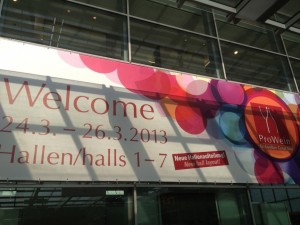
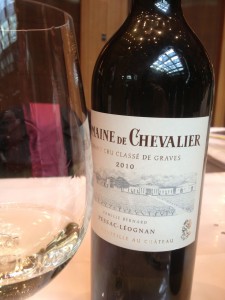
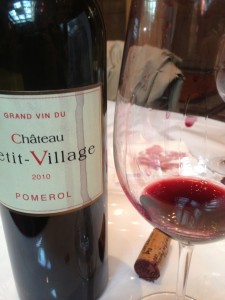
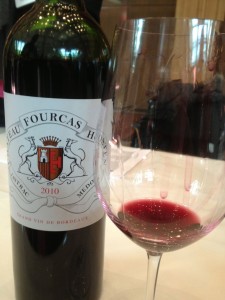
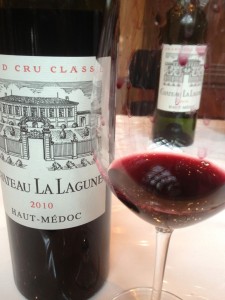
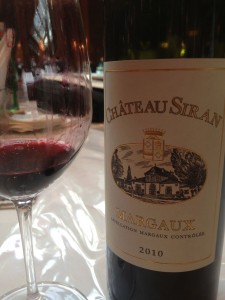
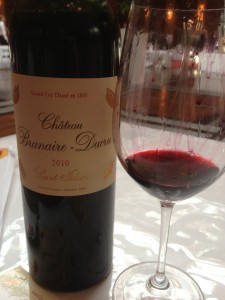
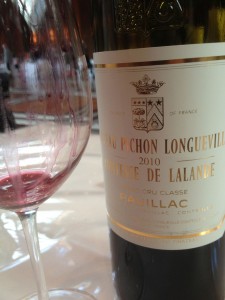
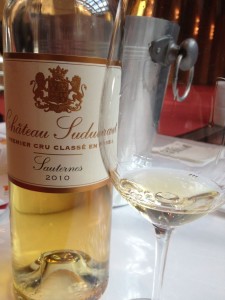
[…] […]
[…] […]
[…] On the 2010 white […]